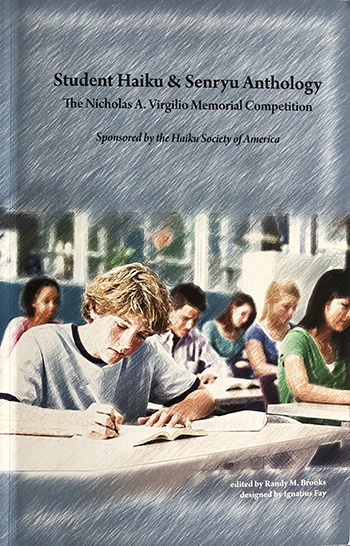Haiku Society of America Student Haiku Awards
in Memorial of Nicholas A. Virgilio
~ ~ ~
Student Haiku Awards for 2002
Raffael DeGruttola and Judson Evans
judges
We read and reread the 242 entries separately, then got together and compared our favorites. We discussed these, compared, and finally agreed on the following selections. ~ Raffael DeGruttola and Judson Evans
hovering
over a damp field
a cloud of gnatsColin Murray
School of the Arts, grade 8, Rochester, NYWe like several things about this haiku. The language is fresh and recreates a subtle seasonal perception with its sense of silence in a very early spring morning. The gnats seem to materialize out of the damp earth. The shape of the poem on the page reinforces the poet’s observation, as the reader recognizes the way the “over” in the first line’s “hovering” rests just above “over” in the second line. The poem interestingly connects the stillness and solidity of the underlying “damp earth” with the almost electric movement of the gnats.
dawn
dust dances
on shafts of sunlightShannon Ryan
School of the Arts, grade 9, Rochester, NYThis haiku combines two phenomena about the given moment, the way dust moves haphazardly yet in patterns the wind creates and how a shaft of light in the early morning can capture a lively scene. A photographer friend once said to me that there is something magical about the early morning light when objects are seen so distinctly. In the eyes of the young writer the dust moves gracefully across a field or meadow and the sun’s light reflects its every move.
summer dusk
throwing stones
through a broken windowTravis Moore
School of the Arts, grade 9, Rochester, NYWith this haiku we are taken to the other end of the day when the young person’s mischievous nature begins to play havoc in the covering blanket of evening. One wonders if the broken window was the result of the first stone thrown or was the window already broken. We hope for the latter; however, boys will be boys, as they say, and windows are just another entry into the world of the night. Again, we can imagine a city lot with an abandoned building where more than one window has already fallen to youthful play. How many of us remember the days of the slingshot when distance and accuracy went hand in hand.
on an old
cemetery stone
my nameJames Isaak
Wahlert High School, grade 12, Dubuque, IAHere we have, to quote the Proustian phrase, “remembrance of things past,” where we see our family name from generations before on a gravestone. There’s a certain ambivalence about this fact. Am I really related to this person? Is this just a coincidence? And, if I am related how much to I know about this person? It’s all in the mystery of not knowing that keeps the charm of this senryu. For the young person, there is a fascination in knowing that somebody with the same name once lived in this city, and if for no other reason, I am alive and must carry on the tradition.
mountain stream
trout dart
around watercressCory Hanson
Wahlert High School, grade 11, Dubuque, IAA true outdoors person is here proclaimed. Accompanying dad and/or grandfather by rising early in the morning to venture out to the wilderness. Then following the stream to where the trout are jumping. Sitting on a rock watching as father throws his line out and slowly reel it in hoping for a catch. The watercress acts as a cover, which makes the adventure that much more intriguing. You can sense the excitement in the moment.
Monday morning
kicking the slush
from behind the wheelsColin Murray
School for the Arts, grade 8, Rochester, NYWe were fascinated by the use of the word “slush” here. In the summer it connotes something refreshing; however, in winter it’s a nuisance. Of course, Monday morning is the beginning of the workweek and you want to start the day without any inconveniences. Removing the slush in the quickest way from the mudguards means kicking it free and climbing into your car with dirty and wet shoes. That feeling of disgust is conveyed with determined abruptness.
~ ~ ~
